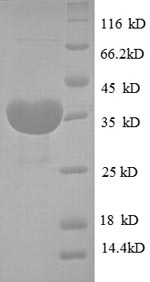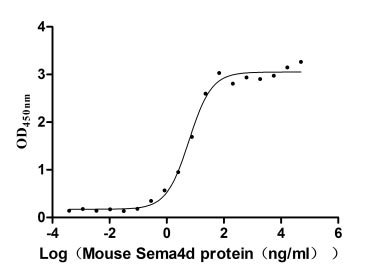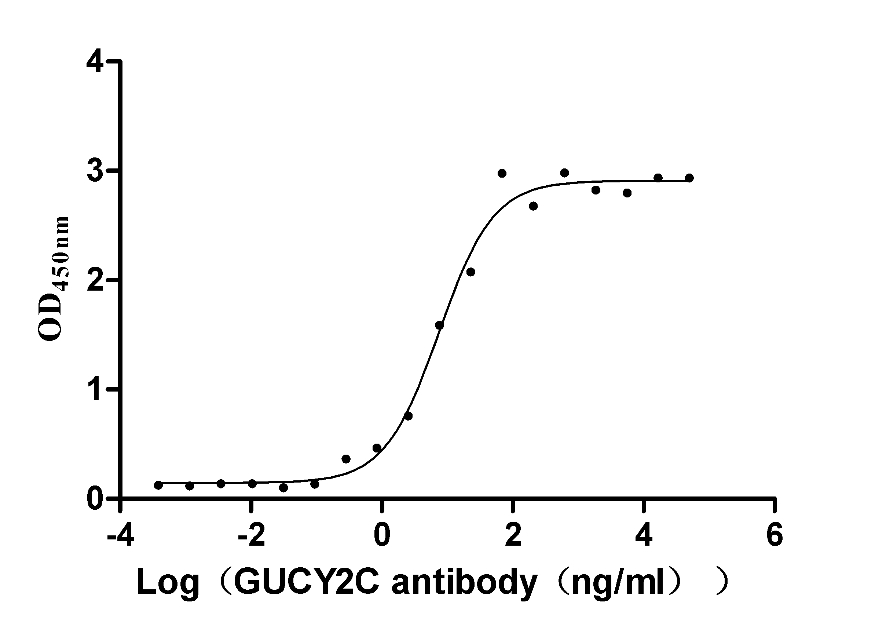Recombinant Human Cystatin-B (CSTB)
In Stock Promotion-
货号:CSB-EP006100HUe0
-
规格:¥1344
-
促销:

-
图片:
-
其他:
产品详情
-
纯度:Greater than 90% as determined by SDS-PAGE.
-
基因名:CSTB
-
Uniprot No.:
-
别名:CHROW21; CPI B; CPI-B; CST 6; CST6; CSTB; Cystatin B (stefin B); Cystatin B; Cystatin-B; CYTB; CYTB_HUMAN; EPM1; EPM1A; Liver thiol proteinase inhibitor; PME; Stefin-B; STF B; STFB; ULD
-
种属:Homo sapiens (Human)
-
蛋白长度:Full Length
-
来源:E.coli
-
分子量:38.1kDa
-
表达区域:1-98aa
-
氨基酸序列MMCGAPSATQPATAETQHIADQVRSQLEEKENKKFPVFKAVSFKSQVVAGTNYFIKVHVGDEDFVHLRVFQSLPHENKPLTLSNYQTNKAKHDELTYF
Note: The complete sequence including tag sequence, target protein sequence and linker sequence could be provided upon request. -
蛋白标签:N-terminal GST-tagged
-
产品提供形式:Liquid or Lyophilized powder
Note: We will preferentially ship the format that we have in stock, however, if you have any special requirement for the format, please remark your requirement when placing the order, we will prepare according to your demand. -
缓冲液:Tris-based buffer,50% glycerol
-
储存条件:Store at -20°C/-80°C upon receipt, aliquoting is necessary for mutiple use. Avoid repeated freeze-thaw cycles.
-
保质期:The shelf life is related to many factors, storage state, buffer ingredients, storage temperature and the stability of the protein itself.
Generally, the shelf life of liquid form is 6 months at -20°C/-80°C. The shelf life of lyophilized form is 12 months at -20°C/-80°C. -
货期:3-7 business days
-
注意事项:Repeated freezing and thawing is not recommended. Store working aliquots at 4°C for up to one week.
-
Datasheet & COA:Please contact us to get it.
相关产品
靶点详情
-
功能:This is an intracellular thiol proteinase inhibitor. Tightly binding reversible inhibitor of cathepsins L, H and B.
-
基因功能参考文献:
- cystatin B expression was significantly and inversely correlated with lung tumor stage and tumor grade PMID: 29037838
- The results demonstrate that cystatin B interferes with the STAT-1 signaling and IFN-beta-antiviral responses perpetuating HIV in macrophage reservoirs. PMID: 27137788
- apoptosis is accompanied by degradation of the cysteine cathepsin inhibitor stefin B (StfB). CatD did not exhibit a crucial role in this step. However, this degradation was partially prevented through pre-incubation with the antioxidant N-acetyl cysteine PMID: 28543404
- Homozygous for a c.218dupT (p.His75Serfs*2) mutation in exon 3 of CSTB causes neurodegeneration, progressive cerebral volume loss and diffuse hypomyelination. PMID: 28378817
- CSTB downregulation may promote the development of gastric cancer. PMID: 28281969
- It was shown that decreased expression of cystatin B enhances cathepsin activity in Niemann-Pick C cerebellar degeneration patient fibroblasts. PMID: 26908626
- High expression of stefin B may be an important factor contributing to the development and metastasis of Hepatocellular Carcinoma. PMID: 26753874
- CSTB null mutation associated with microcephaly, early developmental delay, and severe dyskinesia. PMID: 26843564
- Data shows that CYTB and ANXA4 overexpression may be involved in carcinogenesis and histopathological differentiation of ovarian clear cell carcinoma and suggest they may serve as a potential diagnostic biomarkers. PMID: 25633807
- A role for disease-causing mutations in cystatin B gene in patients with juvenile myoclonic epilepsy was not supported. PMID: 25752200
- Even though the majority of EPM1 patients have a uniform genetic mutation, the actual size of the longer CSTB expansion mutation allele is likely to have a modulating effect on the age at disease onset, myoclonus severity, and cortical neurophysiology. PMID: 25770194
- The study shows detection of stefin B dimers in HEK293 cells and the importance of their residual activity. PMID: 25047918
- glutamate dehydrogenase is a euchromatin-associated enzyme, and its H3 clipping activity is regulated by chromatin structure, histone modifications and an in vivo inhibitor. PMID: 25263734
- detected a homozygous expansion of dodecamer repeats in the CSTB gene in four patients with clinical diagnosis of ULD. PMID: 23883076
- The increased CSTB expression in ovarian tissue represents tumor progression and is dysregulated by the TGF-beta signaling pathway. PMID: 24452274
- A reciprocal influence of CSTB and SOD1 at the gene expression level and for a direct interaction of the two proteins, is reported. PMID: 24234043
- The present study was performed on two more missense mutants of human stefin B, G50E and Q71P, and they similarly showed numerous aggregates upon overexpression. PMID: 24909779
- The co-localization of stefin B wild type and EPM1 mutants with cathepsins showed that cathepsins accumulate around the aggregates formed by the EPM1 mutants. PMID: 23362198
- Skull thickening and an increased prevalence of abnormal findings in skeletal radiographs of patients with EPM1 suggest that this condition is connected to defective cystatin B function. PMID: 23010349
- This study suggested that CSTB mutations other than the common dodecamer expansion predict particular phenotypes, including marked seizure severity and polymorphous seizure types. PMID: 23205931
- Elevated StefA mRNA level is associated with invasive glioblastoma. PMID: 22287159
- S-glutathionylation and S-cysteinylation were described as extensive PTM of a salivary protein and the first time that these PTMs were detected in naturally occurring cystatin B. PMID: 22057043
- patients compound heterozygous for the dodecamer repeat expansion and the c.202C>T mutations seem to have a severer form of Unverricht-Lundborg disease (EPM1) than patients homozygous for the expansion mutation PMID: 21757863
- At pH 7.0 the mutant H75W folded in three kinetic phases to a native-like intermediate, analogous to folding of stefin B at pH 4.8. PMID: 22033403
- Intracellular stefin b aggregation shows a negative correlation with cell survival PMID: 20078424
- Stefin B interacts with histones and cathepsin L in the nucleus PMID: 20075068
- oligomers of stefin B and amyloid-beta interact in vitro and in cells PMID: 19955183
- Oligonucleotides containing EPM1 repeat adopt secondary structures that may facilitate strand slippage thereby causing the expansion. PMID: 11697734
- Intramolecular i-motif structure at acidic pH for progressive myoclonus epilepsy (EPM1) repeat d(CCCCGCCCCGCG)n. PMID: 11697735
- analysed eight markers flanking CSTB(GT10-D21S1890-D21S1885-D21S2040-D21S1259- CSTB-D21S1912-PFKL-D21S171) and one intragenic variant in the CSTB 3' UTR (A2575G) PMID: 12215838
- first demonstration of cysteine protease activity being regulated by CSTB activity in a biological context; effects of decreased CSTB activity in EPM1 pathogenesis may be mediated by cathepsins through increased activity of cathepsins S and L PMID: 12452481
- Prefibrillar oligomers/aggregates of stefin B also increase the surface pressure at an air-water interface, i.e. they have amphipathic character and are surface seeking. PMID: 15955063
- These data show that cystatin B inhibits bone resorption by down-regulating intracellular cathepsin K activity despite increased osteoclast survival. PMID: 16321512
- Study shows that copper binding by stefin B inhibits the amyloid fibril formation and, to a lesser degree, the initial aggregation. PMID: 16939620
- Several alternatively spliced CSTB isoforms were identified in patients with progressive myoclonus epilepsy of Unverricht-Lundborg type . PMID: 17003839
- Results describe the influence of pH and trifluoroethanol on amyloid fibril growth and morphology from human stefin B. PMID: 17701471
- cystatin B in vivo has a polymeric structure sensitive to the redox environment and that overexpression of the protein generates aggregates. PMID: 17920138
- CSTB is specifically overexpressed in most HCCs and is also elevated in the serum of a large proportion of HCC patients PMID: 18281540
- Data show that wild-type stefin B and its Y31 isoform are able to form pores in planar lipid bilayers, whereas the G4R isoform destroys the bilayer by a non pore-forming process. PMID: 18397316
- The mechanism of amyloid-fibril formation by stefin B: temperature and protein concentration dependence of the rates;the observed kinetics follow the nucleation and growth behavior observed for many other amyloidogenic proteins. PMID: 18636508
- potential role for CSTB in HIV replication in placental macrophages PMID: 18951626
- cystatin B interacts with STAT-1 and the levels of STAT-1 tyrosine phosphorylation (but not serine phosphorylation) between uninfected and HIV-infected PM and MDM are differentially regulated. PMID: 19342095
显示更多
收起更多
-
相关疾病:Epilepsy, progressive myoclonic 1 (EPM1)
-
亚细胞定位:Cytoplasm. Nucleus.
-
蛋白家族:Cystatin family
-
数据库链接:
HGNC: 2482
OMIM: 254800
KEGG: hsa:1476
STRING: 9606.ENSP00000291568
UniGene: Hs.695
Most popular with customers
-
Recombinant Human T-cell immunoreceptor with Ig and ITIM domains (TIGIT), partial (Active)
Express system: Mammalian cell
Species: Homo sapiens (Human)
-
Recombinant Mouse Semaphorin-4D (Sema4d), partial (Active)
Express system: Mammalian cell
Species: Mus musculus (Mouse)
-
Recombinant Human Heat-stable enterotoxin receptor (GUCY2C), partial (Active)
Express system: Mammalian cell
Species: Homo sapiens (Human)
-
Recombinant Human Signal transducer CD24 (CD24)-Nanoparticle (Active)
Express system: Mammalian cell
Species: Homo sapiens (Human)
-
Recombinant Human Claudin-6 (CLDN6)-VLPs (Active)
Express system: Mammalian cell
Species: Homo sapiens (Human)
-
Recombinant Human Trophoblast glycoprotein (TPBG), partial (Active)
Express system: Mammalian cell
Species: Homo sapiens (Human)
-
Recombinant Rat Gastric inhibitory polypeptide receptor (Gipr), partial (Active)
Express system: Mammalian cell
Species: Rattus norvegicus (Rat)
-
Recombinant Human Serine/threonine-protein kinase receptor R3 (ACVRL1), partial (Active)
Express system: Baculovirus
Species: Homo sapiens (Human)







-AC1.jpg)













